
Alfonso d'Este was Duke of Ferrara from 1504 to 1534, during the time of the War of the League of Cambrai.

Portrait of Baldassare Castiglione is a c. 1514–1515 oil painting attributed to the Italian High Renaissance painter Raphael. Considered one of the great portraits of the Renaissance, it has an enduring influence. It depicts Raphael's friend, the diplomat and humanist Baldassare Castiglione, who is considered a quintessential example of the High Renaissance gentleman.

Ridolfo di Domenico Bigordi, better known as Ridolfo Ghirlandaio was an Italian Renaissance painter active mainly in Florence. He was the son of Domenico Ghirlandaio.
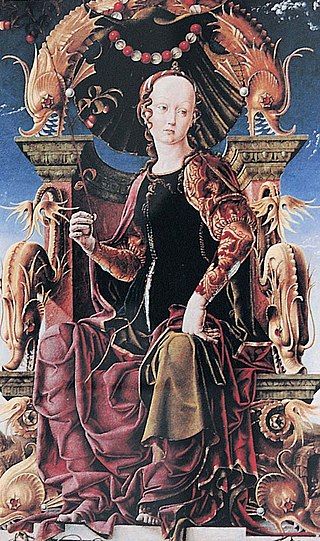
Cosmè Tura, also known as Il Cosmè or Cosimo Tura, was an Italian early-Renaissance painter and considered one of the founders of the School of Ferrara. He provided a great contribution to the Renaissance in Ferrara.
The School of Ferrara was a group of painters which flourished in the Duchy of Ferrara during the Renaissance. Ferrara was ruled by the Este family, well known for its patronage of the arts. Patronage was extended with the ascent of Ercole d'Este I in 1470, and the family continued in power till Alfonso II, Ercole's great-grandson, died without an heir in 1597. The duchy was then occupied in succession by Papal and Austrian forces. The school evolved styles of painting that appeared to blend influences from Mantua, Venice, Lombardy, Bologna, and Florence.
Sebastiano Filippi was an Italian late Renaissance – Mannerist painter of the School of Ferrara.

Francesco Costanzo Catanio, was a painter of the Italian Baroque period, born and mainly active in Ferrara. He was variously known as Catanio, Cattani, Cattaneo, or Cattanio, sometimes without the forename Francesco.
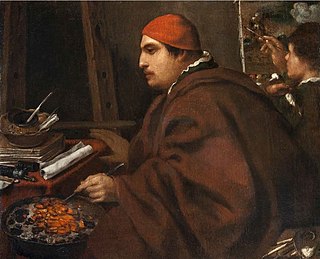
Giuseppe Caletti or Calletti was an Italian painter and engraver of the Baroque period, active in Ferrara and Cremona. He often painted religious themes in a genre like dress and surroundings, including the theme of Bacchanalia like Titian.

Vittorio Bigari was an Italian painter of the late-Baroque period.
Alfonso Rivarola was an Italian painter of the Baroque period, active mainly in Ferrara, where he was born. He is also known as il Chenda because of an inheritance he received from someone with that name.
The decade of the 1440s in art involved some significant events.
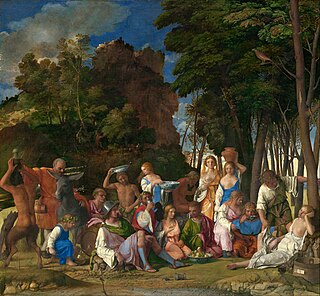
The Feast of the Gods is an oil painting by the Italian Renaissance master Giovanni Bellini, with substantial additions in stages to the left and center landscape by Dosso Dossi and Titian. It is one of the few mythological pictures by the Venetian artist. Completed in 1514, it was his last major work. It is now in the National Gallery of Art in Washington D.C., which calls it "one of the greatest Renaissance paintings in the United States".

Francesco Bianchi was an Italian painter of the Renaissance period. He is also known as Francesco del Bianchi Ferrara and Il Frare. He was born at Ferrara. Modena is also mentioned as the place of his birth. His works were much esteemed in his time. He was a pupil of Cosimo Tura. He is said to have been an instructor of Correggio, but Bianchi would have died when the former was only 16 years old.

Antonio Begarelli, also known as Begarino (1499–1565) was an Italian sculptor. In the 16th century, he was the dominant force in terracotta production in Modena.

The Galleria Estense is an art gallery in the heart of Modena, centred around the collection of the d’Este family: rulers of Modena, Reggio and Ferrara from 1289 to 1796. Located on the top floor of the Palazzo dei Musei, on the St. Augustine square, the museum showcases a vast array of works ranging from fresco and oil painting to marble, polychrome and terracotta sculpture; musical instruments; numismatics; curios and decorative antiques.
Giovanni Maria Chiodarolo was an Italian painter from Bologna who lived in the 15th century. Little further is known of him than that the fresco of Angel crowning St. Valerian and St. Cecilia, executed about 1504–1509, in the oratory of St. Cecilia, attached to San Giacomo Maggiore, in Bologna, is by tradition assigned to him. He painted there alongside Cesare Tamarozzo. Other frescoes in the oratory were done by Francia, Amico Aspertini, and Lorenzo Costa the Elder. A Nativity in the Bologna Gallery is also ascribed to Chiodarolo.
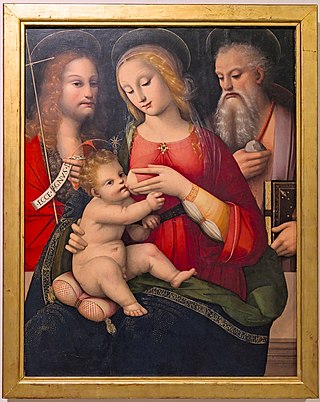
Andrea del Brescianino or Dei Piccinelli was an Italian painter of the Renaissance period, active mainly in Siena. Together with his brother Raffaello they were known as the Brescianini of Siena.

Ercole dell'Abate or dell'Abbate (1573–1613) was an Italian mannerist painter in his native Modena. In English, his name is sometimes given as Ercole Abbate, Abate or Abati.
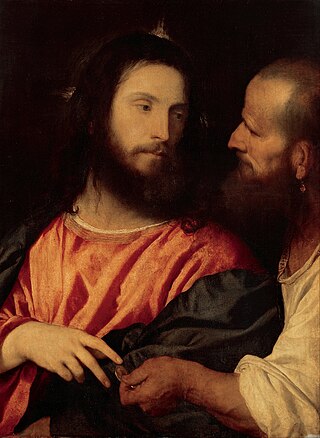
The Tribute Money is a panel painting in oils of 1516 by the Italian late Renaissance artist Titian, now in the Gemäldegalerie Alte Meister in Dresden, Germany. It depicts Christ and a Pharisee at the moment in the Gospels when Christ is shown a coin and says "Render unto Caesar the things that are Caesar's, and unto God the things that are God's". It is signed "Ticianus F.[ecit]", painted on the trim of the left side of the Pharisee's collar.
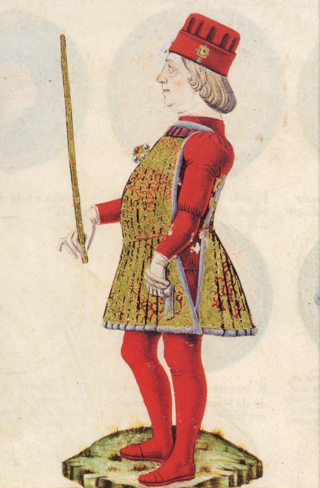
The Genealogia dei principi d'Este is an illuminated manuscript on parchment bound as a codex and containing a genealogy of the House of Este. The manuscript has no title. The name by which it is now known is conventional.

















